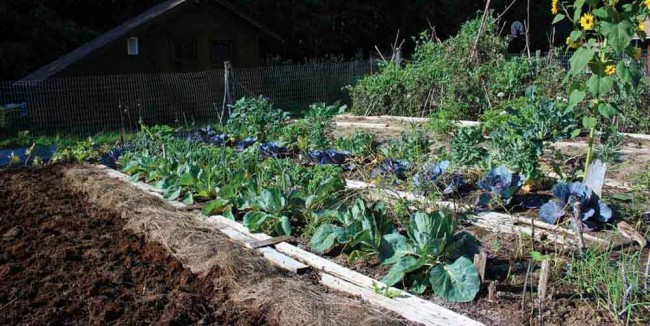
Photo Credit: Norma Kerby
Sunny Slopes and Garden Growth: Approaching your crops from a new angle
On a moderate, southwest-facing slope near Terrace, the remnants of a 100-year-old orchard grow as ragged witness to the agricultural era in the lower Skeena Valley. Years ago, as a child, I would join my family in picking fruit from those aging, broken trees. Even then, I wondered why someone would plant apple trees on a slope, rather than across the flat land at the bottom.
As we picked apples in the fading autumn sun, the warmth of the slope, compared to the cool air in the meadow at the base of the hill, should have told me why old-timers sought out south-facing slopes for their fruit orchards. Their understanding of slopes’ climatic advantages has largely been lost from many modern methods of gardening and farming.
At the upper boundary of the mid-latitude zone, many communities in our region are located above 55 degrees in what is classified as the subarctic zone. Our share of the solar radiation hitting the Earth’s surface is less than 50 percent of that reaching the tropics. Any technique that increases the amount and quality of sunshine reaching your garden and warming your soil is an advantage for growing food.
The sun is most intense when it strikes perpendicular to a surface. As it is never directly overhead at our distance from the Equator, the advantage of a southerly slope is its ability to capture more intense radiation than that hitting flat land. A garden designed to take advantage of this will have warmer soils and higher productivity, as long as there is sufficient moisture.
This is how it works: If we start March 20, the spring equinox, for a garden at the latitude of Smithers or Terrace (54 degrees north), the maximum angle the sun rises above the horizon is 36 degrees, with incoming sunshine arriving at an angle of 36 degrees to a flat surface. The slope perpendicular to the incoming radiation can be calculated on the geometric principle that the sum of the remaining angles in a right-angle triangle is 90 degrees. Therefore, a south-facing slope of 54 degrees would receive the most intense sunlight.
If you wish to encounter the earliest exposed ecosystems in the spring, a south-facing slope in the range of 40 to 60 degrees will often be the one that has melted the quickest and has the most wildlife activity. By the summer solstice on June 21, the sun has reached a maximum noontime altitude of 58 degrees, with a southerly slope of 32 degrees receiving the most intense radiation.
In the Bulkley Valley, the upper reaches of these types of slopes are the hottest and driest summer locations and can experience ground-moisture shortages. On slopes where there has been limited environmental damage, these warm, dry slopes support naturally treeless ecosystems. If we were farther south, such as the Okanagan Valley, the mid and lower reaches of these southerly slopes would be supporting fruit orchards or vineyards. In the northern interior, they are often the best locations for productive hayfields and pastures.
Value for northern gardeners
If you are fortunate enough to be located on a south-facing slope with tillable, fertile soils and sufficient moisture, your garden will be warmer and more productive than one on flat land or a north-facing slope. Even a short slope, as long as there is sufficient moisture, can offer significant advantages for growing heat-loving crops. One family I know near Smithers lives in the lower third of a steep, southwest-facing hill. The warm air generated by the slope acts as a warming oven to heat the garden boxes and greenhouse clustered on the bench for their home.
If your garden is like mine, on flat land, you can construct micro-slopes to take advantage of incoming solar radiation. My garden is raised above the surrounding ground and solar radiation hitting the sloped, raised edges elevates soil temperature in a band around the garden. This is the zone where I plant my early potato varieties. Most years we are able to eat new potatoes by July 1. For the remainder of my heritage potatoes, the rows are oriented east to west. Hilling the plants creates long, south-facing micro-slopes that allow soil warming and better potato productivity.
For heat-loving crops such as pumpkin and squash, dirt mounds elevate the soil and take advantage of solar radiation heating the small slopes. For finicky crops such as corn, which in the inland coastal valleys is very much a hit-and-miss crop depending upon weather conditions, I have constructed my garden in steps. Years when I feel like gambling on the weather, I plant corn along the edge of the highest step in order to take advantage of my garden’s warmest soils.
Soaking up sun
Some old-timers took slopes and solar radiation to an even more interesting level. To understand what they were doing, there is another characteristic of incoming radiation that we need to understand. You can increase the intensity of sunshine by a slope’s angle to the incoming radiation, but how that radiation is transmitted into the ground as heat depends upon the colour and type of material at the surface.
Wet, light-coloured, organic material is a poor conductor of heat and is one reason why soils stay cool and moist under compost layers. If hot, dry soils are a problem for your garden, then compost layers will keep the root layers moist and cool. If colder soils are a problem, thick organic layers on the surface may reduce soil temperatures to the point that crops such as carrots and turnips do not grow well. Even non-root crops such as kale and broccoli will be less productive growing in soils that are too cold for vigorous root growth.
To elevate soil and air temperatures, some northern BC homesteaders used lithic gardening techniques, or the use of rock to conduct heat into the soil. Large, dark-coloured stones half buried along the north side of a crop, such as a cluster of kohlrabi, will not only capture radiation on their sloped sides, but will rapidly conduct this heat into the ground. The old-timers who lived at higher elevations or in colder valleys could dramatically increase their vegetable crops by using this technique. Some even went as far as building stone walls on the slopes, which also helped develop terraces of garden soil and direct cold-air drainage away from their plants.
We live in a zone where solar heating strongly contrasts between microhabitats. Whether it is building a thermal wall in your greenhouse, using micro-slopes and stones to raise your soil temperatures or making your soil as dark as possible, adapting your garden to the characteristics of our northern sunshine will give direct benefits in the amount of food that you can grow.
Information about the cycles of solar altitude and length of daylight, as well as the abilities of various materials to reflect or absorb solar radiation or conduct heat, can be found in a technical book available on-line called Smithsonian Meteorological Tables. It is initially a challenging book to use, but has a wealth of information about solar characteristics at different latitudes.




